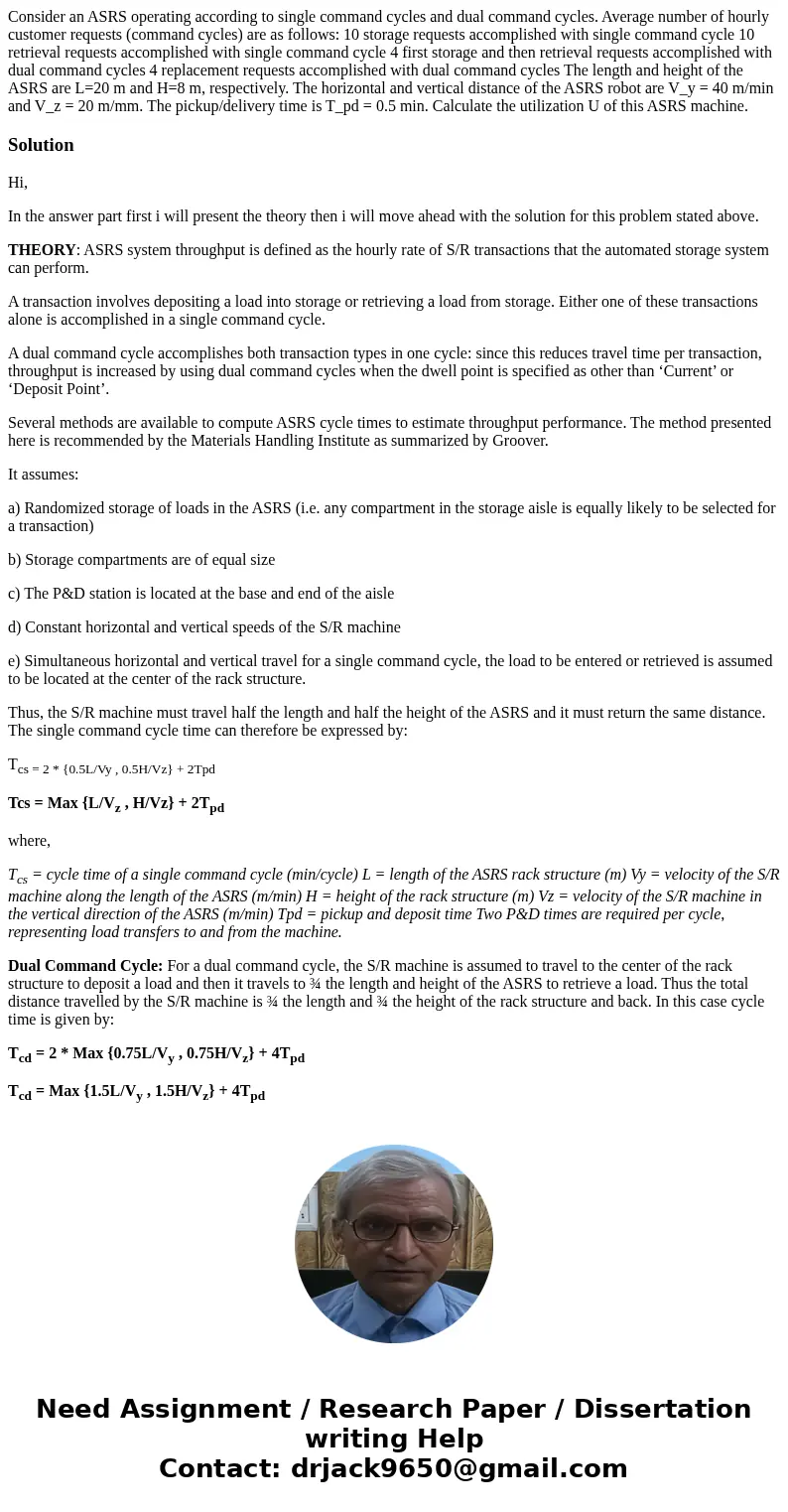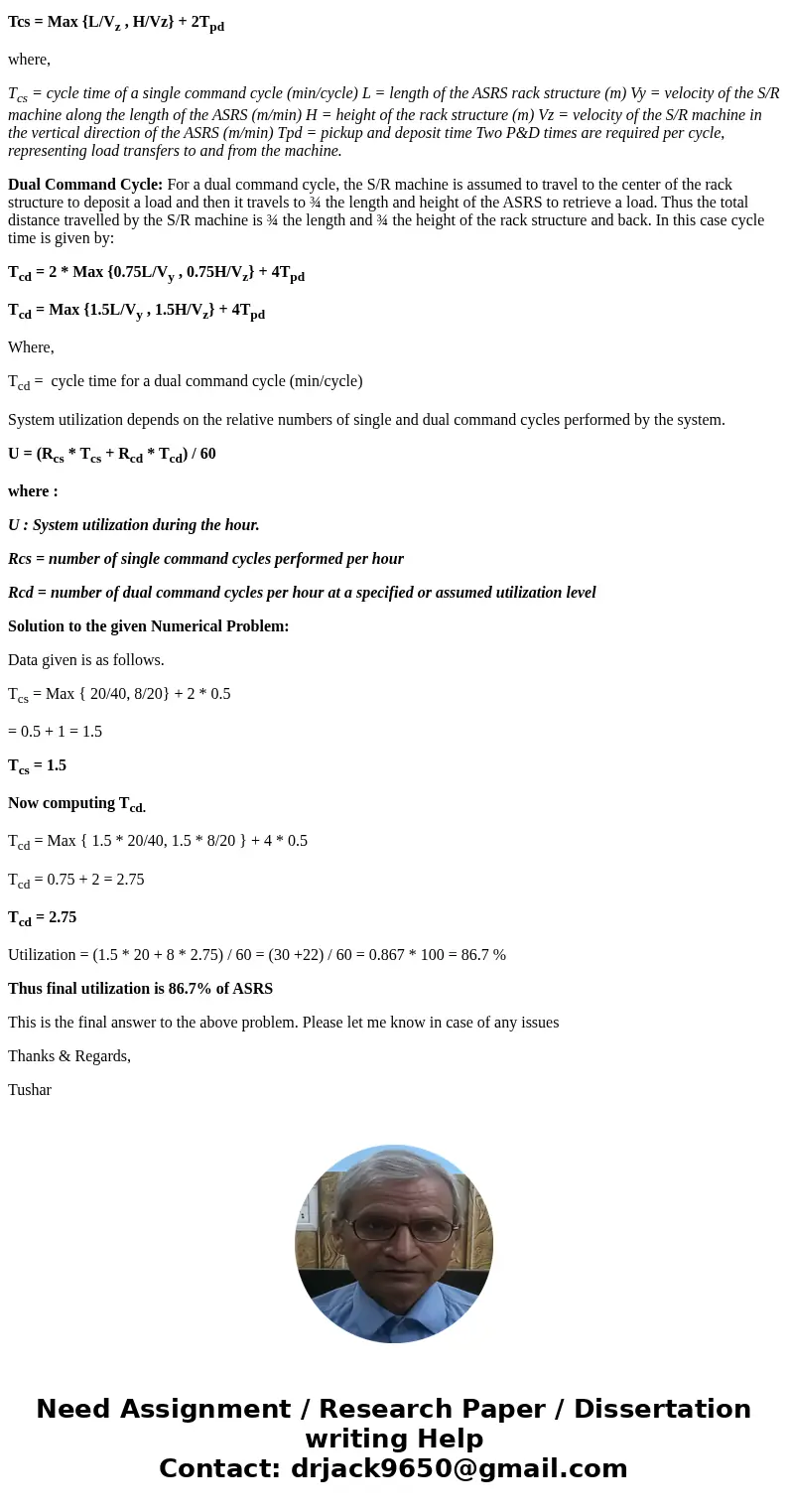Consider an ASRS operating according to single command cycle
Solution
Hi,
In the answer part first i will present the theory then i will move ahead with the solution for this problem stated above.
THEORY: ASRS system throughput is defined as the hourly rate of S/R transactions that the automated storage system can perform.
A transaction involves depositing a load into storage or retrieving a load from storage. Either one of these transactions alone is accomplished in a single command cycle.
A dual command cycle accomplishes both transaction types in one cycle: since this reduces travel time per transaction, throughput is increased by using dual command cycles when the dwell point is specified as other than ‘Current’ or ‘Deposit Point’.
Several methods are available to compute ASRS cycle times to estimate throughput performance. The method presented here is recommended by the Materials Handling Institute as summarized by Groover.
It assumes:
a) Randomized storage of loads in the ASRS (i.e. any compartment in the storage aisle is equally likely to be selected for a transaction)
b) Storage compartments are of equal size
c) The P&D station is located at the base and end of the aisle
d) Constant horizontal and vertical speeds of the S/R machine
e) Simultaneous horizontal and vertical travel for a single command cycle, the load to be entered or retrieved is assumed to be located at the center of the rack structure.
Thus, the S/R machine must travel half the length and half the height of the ASRS and it must return the same distance. The single command cycle time can therefore be expressed by:
Tcs = 2 * {0.5L/Vy , 0.5H/Vz} + 2Tpd
Tcs = Max {L/Vz , H/Vz} + 2Tpd
where,
Tcs = cycle time of a single command cycle (min/cycle) L = length of the ASRS rack structure (m) Vy = velocity of the S/R machine along the length of the ASRS (m/min) H = height of the rack structure (m) Vz = velocity of the S/R machine in the vertical direction of the ASRS (m/min) Tpd = pickup and deposit time Two P&D times are required per cycle, representing load transfers to and from the machine.
Dual Command Cycle: For a dual command cycle, the S/R machine is assumed to travel to the center of the rack structure to deposit a load and then it travels to ¾ the length and height of the ASRS to retrieve a load. Thus the total distance travelled by the S/R machine is ¾ the length and ¾ the height of the rack structure and back. In this case cycle time is given by:
Tcd = 2 * Max {0.75L/Vy , 0.75H/Vz} + 4Tpd
Tcd = Max {1.5L/Vy , 1.5H/Vz} + 4Tpd
Where,
Tcd = cycle time for a dual command cycle (min/cycle)
System utilization depends on the relative numbers of single and dual command cycles performed by the system.
U = (Rcs * Tcs + Rcd * Tcd) / 60
where :
U : System utilization during the hour.
Rcs = number of single command cycles performed per hour
Rcd = number of dual command cycles per hour at a specified or assumed utilization level
Solution to the given Numerical Problem:
Data given is as follows.
Tcs = Max { 20/40, 8/20} + 2 * 0.5
= 0.5 + 1 = 1.5
Tcs = 1.5
Now computing Tcd.
Tcd = Max { 1.5 * 20/40, 1.5 * 8/20 } + 4 * 0.5
Tcd = 0.75 + 2 = 2.75
Tcd = 2.75
Utilization = (1.5 * 20 + 8 * 2.75) / 60 = (30 +22) / 60 = 0.867 * 100 = 86.7 %
Thus final utilization is 86.7% of ASRS
This is the final answer to the above problem. Please let me know in case of any issues
Thanks & Regards,
Tushar


 Homework Sourse
Homework Sourse